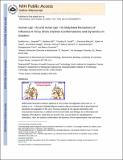Human (α2→6) and Avian (α2→3) Sialylated Receptors of Influenza A Virus Show Distinct Conformations and Dynamics in Solution
Author(s)
Sassaki, Guilherme L.; Elli, Stefano; Rudd, Timothy R.; Macchi, Eleonora; Yates, Edwin A.; Naggi, Annamaria; Raman, Rahul; Torri, Giangiacomo; Guerrini, Marco; Shriver, Zachary H.; Sasisekharan, Ram; ... Show more Show less
DownloadSasisekharan_Human.pdf (1.845Mb)
PUBLISHER_POLICY
Publisher Policy
Article is made available in accordance with the publisher's policy and may be subject to US copyright law. Please refer to the publisher's site for terms of use.
Terms of use
Metadata
Show full item recordAbstract
Differential interactions between influenza A virus protein hemagglutinin (HA) and α2→3 (avian) or α2→6 (human) sialylated glycan receptors play an important role in governing host specificity and adaptation of the virus. Previous analysis of HA–glycan interactions with trisaccharides showed that, in addition to the terminal sialic acid linkage, the conformation and topology of the glycans, while they are bound to HA, are key factors in regulating these interactions. Here, the solution conformation and dynamics of two representative avian and human glycan pentasaccharide receptors [LSTa, Neu5Ac-α(2→3)-Gal-β(1→3)-GlcNAc-β(1→3)-Gal-β(1→4)-Glc; LSTc, (Neu5Ac-α(2→6)-Gal-β(1→4)-GlcNAc-β(1→3)-Gal-β(1→4)-Glc] have been explored using nuclear magnetic resonance and molecular dynamics simulation. Analyses demonstrate that, in solution, human and avian receptors sample distinct conformations, topologies, and dynamics. These unique features of avian and human receptors in solution could represent distinct molecular characteristics for recognition by HA, thereby providing the HA–glycan interaction specificity in influenza.
Date issued
2013-09Department
Harvard University--MIT Division of Health Sciences and Technology; Massachusetts Institute of Technology. Department of Biological Engineering; Massachusetts Institute of Technology. School of Engineering; Koch Institute for Integrative Cancer Research at MITJournal
Biochemistry
Publisher
American Chemical Society (ACS)
Citation
Sassaki, Guilherme L., Stefano Elli, Timothy R. Rudd, Eleonora Macchi, Edwin A. Yates, Annamaria Naggi, Zachary Shriver, et al. “Human (α2→6) and Avian (α2→3) Sialylated Receptors of Influenza A Virus Show Distinct Conformations and Dynamics in Solution.” Biochemistry 52, no. 41 (October 15, 2013): 7217–7230.
Version: Author's final manuscript
ISSN
0006-2960
1520-4995